Fossil Hunters in the Classroom
This year, almost 700 students at six schools in L.A. have participated in microfossil sorting.

Libby Ellwood, a Research Fellow at the La Brea Tar Pits, stood in front of a boisterous group of 7th graders at Los Angeles Academy Middle School recently and handed them a kit and a mission: find fossils.
The students, separated into pairs, each got a scoop of matrix (the sediment surrounding the larger fossils from the La Brea Tar Pits), a paper sheet to sort them into categories (plants, bones, rocks, and other), a paintbrush, a magnifying lens, and a booklet with illustrations to help them identify their finds. “Each scoop of matrix contains little bones — microfossils — that our researchers use to understand all about the Ice Age animals and plants that used to live about 40,000 years ago right here in Los Angeles,” Ellwood says to the class. La Brea Tar Pits Assistant Collections Manager Noel Graham, working alongside Ellwood, adds, “We’re really excited that you guys are helping us.”
Well before heavy trucks started rumbling down Wilshire Boulevard, mammoths, dire wolves, and saber-toothed cats prowled, ate, and eventually got stuck in the sticky asphalt. La Brea Tar Pits researchers have discovered that tiny animals, such as rodents, lizards, birds, and insects, lived alongside these and other large creatures during the Ice Age. And the animal bones are all jumbled up together with plants, leaves, seeds, and other organisms that made up the Pleistocene ecosystem. But Ellwood and other researchers are excited about fleshing out the picture of what the ecological landscape looked like, particularly the food webs — that is, who was eating what. The tiniest of specimens, a twig or beetle’s wing, can help museum scientists understand why some animals went extinct and others were more resilient to a changing environment, what climate was like at the end of the last Ice Age, and what that can tell us about our future.
DIGGING IN
In the classroom, the pairs of 7th graders quickly commit to their fossil hunting mission. Twelve-year-old Kev’vina Williams sits with Maria Mercado, both of them gingerly brushing away the dirt until a fragment of a rabbit skull emerges and then a rodent toe. “I’m scared of rabbits, but this is awesome,” says Kev’vina. At a nearby table, Ana Ara, 12, says this activity makes her think about the animals of the past and what was prowling around here back then. “I really like finding out what happened before we were born,” she says. “They were roaming around free and now we’re here looking at their bones. I bet they didn’t’ expect that!”
Another pair, Valeria Vargas, 12, and Maria Lopez, 13, uncovered a rabbit jaw and their eyes went wide. Ellwood stopped over to see what they’d discovered. “You see the little teeth in there?” she smiles. “Total jackpot.” When the school bell rings, the kids deliver their treasures to their teacher, and spill out into the hallway. The next class flows in, gets their tools, instructions, and starts their microfossil treasure hunt. Twelve-year-old Miguel Santibañez and Brian Lora, 13, found little lizard teeth and then a claw from some unknown animal. (The specimens are all taken back to the lab for identification.)
“I think it’s amazing to get a chance to look at fossils; they’re like micro bones,” says Miguel. Brian nods in agreement. “It’s like we’re making history because we’re finding fossils from animals that could have gone extinct a long time ago.”
This year, almost 700 students at six schools in L.A. have participated in microfossil sorting. This classroom project complements the efforts of dozens of museum volunteers who are meticulously sorting this material every day in the Fossil Lab. They are specifically looking for the teeth and jaws of small mammals, an enterprise that is directly contributing to research on what those creatures ingested as they scurried around Ice Age L.A.
When the bell rings for the next period and students take their seats, their teacher, Kristen Brown, gives the middle schoolers something big to think about when they are sifting through the small stuff.
“We have to understand how things worked in the past to understand how they will in the future. The climate is changing and you can see which animals survived. Coyotes are here now and they were found in the Ice Age. How did coyotes survive but dire wolves didn’t? There are so many questions! See? Your mind is going, going, going.”